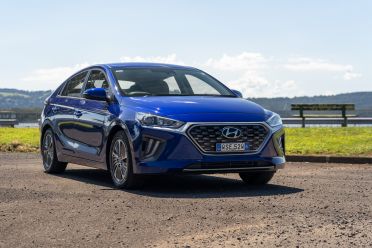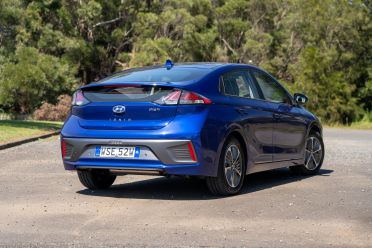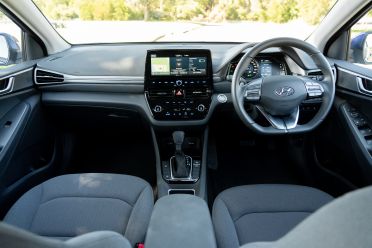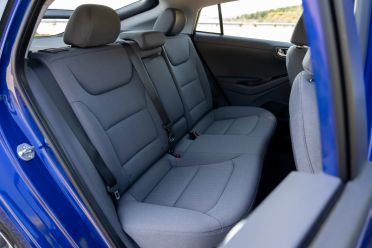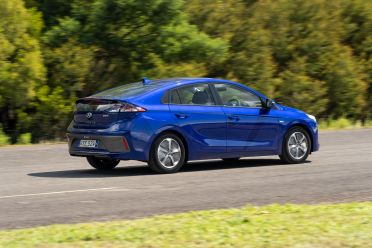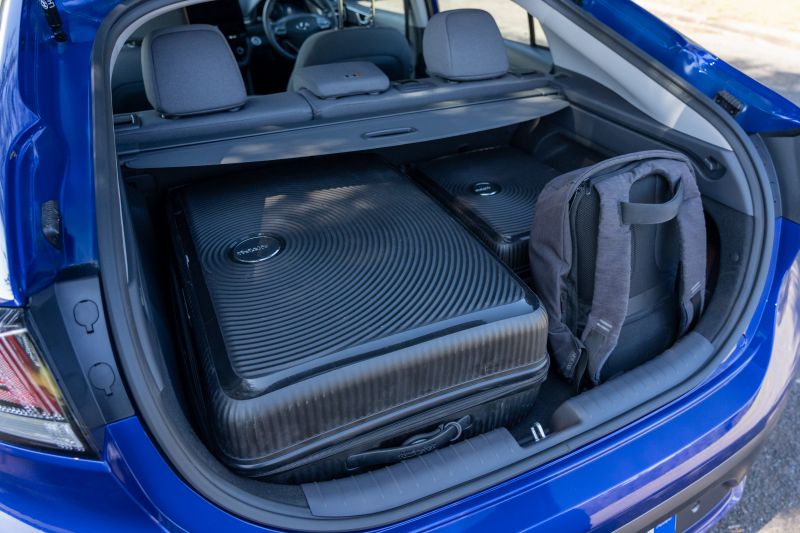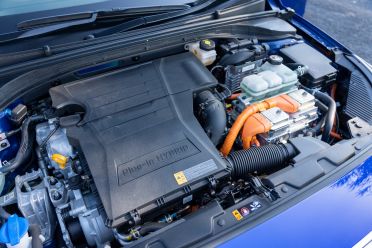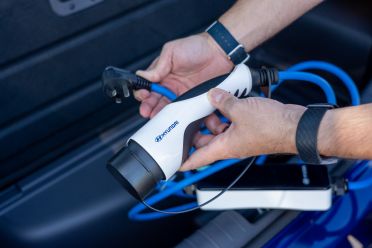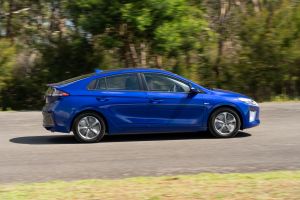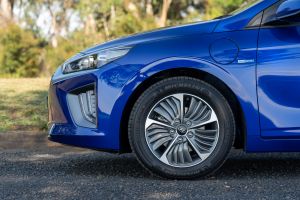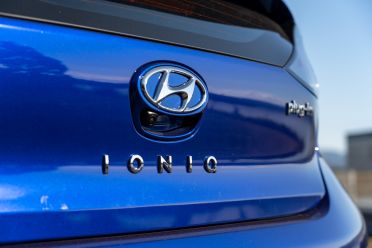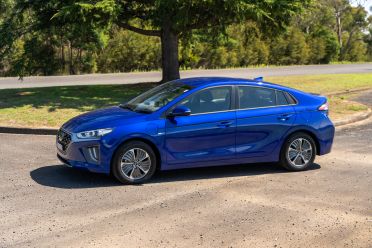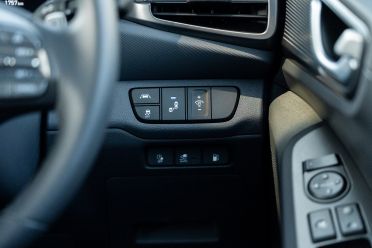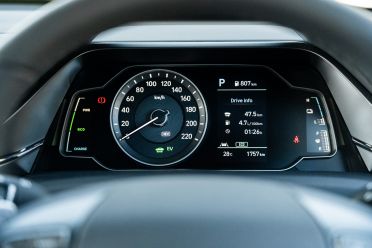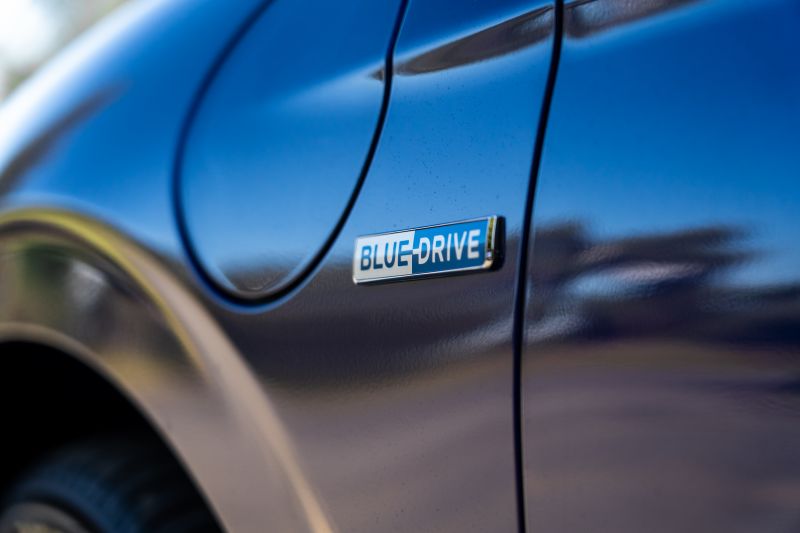Introduction
Plug-in hybrids are, on paper at least, the goldilocks solution to electric power in 2019. With a battery and usable electric range, they can creep smoothly and silently around town during the week.
And when the weekend rolls around, there’s an old-fashioned petrol engine under the bonnet capable of going as far as your imagination (and wallet) will take you.
That’s the pitch when it comes to the 2020 Hyundai Ioniq Plug-In.
How much does the 2020 Hyundai Ioniq Plug-In Elite cost?
The Hyundai Ioniq you see here is priced from $41,990 before on-road costs, making it $6200 more expensive than the equivalent Hybrid Elite and $6500 cheaper than pure-electric Elite model sitting above it in the range.
What do you get?
Standard equipment in the Elite is generous, even though there’s a better-featured Premium model sitting above it in the Plug-In range.
It rides on a set of 15-inch alloy wheels, and has been treated to a comprehensive makeover externally with a much more handsome nose, slightly tweaked detailing, and a sharper rear end.
Inside, the existing 7.0-inch infotainment screen has been replaced for a 10.25-inch touchscreen shared with the updated i30 and related Kia Seltos.
Satellite navigation is standard, along with Apple CarPlay and Android Auto, digital radio, Bluetooth, an eight-speaker audio system, and dual-zone climate control.
Keyless entry and start are included, while the whole range features autonomous emergency braking (AEB), lane-keeping assist, blind-spot monitoring, adaptive cruise control, rear cross-traffic alert, reverse AEB, and driver attention monitoring.
There’s fashionable grey cloth seat trim, soft-touch dashboard trim, and leather for the gear knob and steering wheel.
This being a part-time electric vehicle, the home wall plug is included too. Generous.
Is the 2020 Hyundai Ioniq Plug-In Elite safe?
The entire Ioniq range has a five-star safety rating from ANCAP, based on testing carried out in 2016.
The entire range features seven airbags, along with the suite of semi-autonomous safety systems mentioned earlier.
What is the 2020 Hyundai Ioniq Plug-In Elite like inside?
There was nothing particularly wrong with the original Ioniq, but last year’s update has significantly improved things behind the wheel.
The seats are trimmed in soft, premium-feeling grey cloth, while the centre stack has been overhauled to house a new 10.25-inch touchscreen infotainment system.
Gone are the physical shortcut buttons and separate climate controls, replaced with capacitive ones. They aren’t as tactile as the old, chunky buttons, but still represent an ergonomic improvement over some pure-touchscreen systems.
Button and knob chat aside, the new infotainment system is a huge step forward from the system in the old Ioniq – not that there was much wrong with it to start with.
It’s logically laid out, crystal clear, and responds quickly to your touch. Although the inbuilt navigation is fine, smartphone mirroring is standard and looks excellent across the widescreen display. We stuck with Google Maps, and we’d suggest most owners will too.
There’s an abundance of storage space, with a generous (open) space at the base of the centre console, cupholders on the transmission tunnel, a cut-out where the handbrake might have gone, and a spacious central bin.
The driving position is excellent, with enough (manual) seat adjustment and range from the steering wheel to accommodate tall drivers without stress.
Things aren’t so rosy in the rear, where legroom is limited and headroom is badly compromised by the aero-friendly sloping rear end.
If you’re under six-feet tall it’s bearable, but given the Ioniq is becoming popular with taxi and rideshare driver there’s a strong chance someone lanky will be forced to suffer at some point.
Boot space is appropriate given the car’s compact footprint, with a claimed 341L with the rear seats in place and 1401L with them folded flat. The sloping hatchback helps here, providing a broad opening and almost wagon-like roofline if you’re into carrying big items.
What’s under the bonnet?
The party piece in the Plug-In is undoubtedly its plug-in hybrid drivetrain. In the petrol corner is a 1.6-litre four-cylinder naturally-aspirated engine operating on the Atkinson Cycle, making 77kW and 147Nm.
In the electric corner is a motor on the front axle with 44.5kW and 170Nm, hooked up to an 8.9kWh lithium-ion battery.
For the uninitiated, that means the motor is capable of low- and medium-speed running, while the lithium-ion battery has less than 25 per cent the capacity of the unit in the pure-electric Ioniq.
Charging takes just over two hours when connected to a home or garage wall box, or closer to five hours connected to a regular three-pin outlet.
According to the Hyundai, a full battery allows for 63km of pure-electric driving, while combined fuel economy on the strict WLTP test cycle is just 1.1L/100km.
Impressive on paper, but difficult to replicate in the real world unless your circumstances are perfect. More on that to come.
How does the 2020 Hyundai Ioniq Plug-In Elite drive?
There’s no doubt you’re driving a Hyundai from the second you hop behind the wheel.
Thanks partly to a strong foundation from head office in South Korea, and no doubt partly to the tuning carried out by Hyundai locally, the entire range shares a few key characteristics.
The Ioniq has light, direct steering that errs on the side of comfort around town. It’s dead easy to slot into parking spots, but also offers enough weight and reassurance at higher speeds.
Like the i30 and Kona with which it’s related, the ride treads a line between sporty and comfortable – albeit erring on the side of comfortable, aided by the combination of compact 15-inch alloy wheels and tyres with a properly chubby sidewall.
There’s a lot going on under the bonnet of the Ioniq Plug-In. It’s capable of operating as an electric vehicle, a petrol-powered vehicle, and of leaning on petrol and electric power together when required.
If that wasn’t enough, the petrol engine can also be used to charge the battery on the move.
It all sounds very complex. That’s because it is. But you’re well insulated from all the cleverness going on from behind the wheel.
When it has a full battery, the Plug-In defaults to electric power whenever possible. That means you get smooth, quiet acceleration away from traffic lights and strong response when you lean on the throttle below around 80km/h.
The smoothness and response can’t quite match that of a dedicated electric vehicle though, because the motor isn’t powerful like an Ioniq Electric’s and has to work with the same six-speed dual-clutch transmission as the petrol engine.
The Ioniq Plug-In also suffers when it comes to energy regeneration under braking. It’s actually turned off by default when the car is started, but can be toggled through three modes using the paddles behind the wheel on the move.
It doesn’t operate as predictably as the system in Hyundai’s own Kona EV, let alone that of cars like the Tesla Model 3, which can make driving around town a bit jerky.
The fact it cuts out at 15km/h, forcing the driver to use the brake pedal to stop, also means one-pedal driving is out of the question – removing one of the most enjoyable elements of electric vehicle ownership in the process.
Although the Ioniq’s adaptive cruise control smoothly maintains a gap to the car in front, Hyundai’s new highway-speed lane-keeping assist system needs work.
It tugs aggressively at the wheel and never seems to settle. That would be bearable if it stuck determinedly to the centre of your lane, but it’s far too prone to pinballing from side-to-side, and is easily distracted by tyre marks or shiny patches on the road.
How much does the Ioniq Plug-In Elite cost to run?
The big question with any hybrid is fuel economy.
There’s no doubt the Ioniq Plug-In is very efficient, especially with a full charge.
We saw 1.1L/100km on a run to Melbourne Airport, which is well beyond what’s possible with a sensibly-driven Toyota hybrid, let alone an unelectrified petrol engine.
And if you have facilities to keep the battery fully charged – a garage with reliable access to a three-pin plug or wall box – that figure is achievable day-to-day.
But when the battery goes flat you can expect to see fuel use closer to 5.0L/100km, which is what’s to be expected from a cheaper, simpler series hybrid.
The upshot? The Ioniq is incredibly efficient if you can charge it, or a heavy and complex way of achieving average economy most of the time if you can’t.
Servicing is required every 12 months or 15,000km – whichever comes first. The first three services each cost $265, which the fourth will set you back $465.
As with the wider Hyundai range, the Ioniq Plug-In Elite is backed by a five-year, unlimited-kilometre warranty.
CarExpert’s take on the 2020 Hyundai Ioniq Plug-In Elite
Under the right conditions, the Ioniq Plug-In is a compelling package. If you have somewhere to charge it but still want the flexibility of an internal-combustion engine, there aren’t many alternatives.
After all, Toyota refuses to bring the Prius Prime to Australia, instead persisting with its series hybrid system.
To these eyes, the Ioniq is also an excellent size, packed with the right technology, and drives nicely enough to make it an attractive purchase.
If you can’t charge it? Don’t bother with the Plug-In. A regular hybrid is cheaper, and will offer similar efficiency most of the time.
Given the money and a garage, I would strongly consider buying one. Most of my driving is in the city and well within the 60km pure-electric bubble, so the idea of a tiny fuel bill is attractive.
But having an internal-combustion engine is also just… nice – especially if you’re a skier and occasionally drive five hours to chase turns every winter like me.
Unfortunately, at the moment, I don’t have anywhere to charge it. So I couldn’t buy it.





